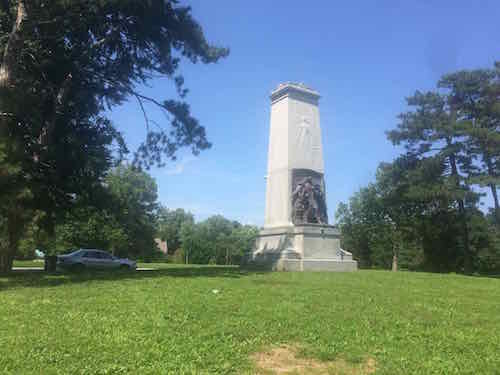Learn From Embarrassing History, Don’t Brush It Under The Rug
Late last month New Orleans was in the news, causing me think about St. Louis’ own confederate statue. .
New Orleans has taken a first major step in fulfilling its 2015 promise to tear down four prominent Confederate statues, an attempt to scrub the city’s public spaces of what many see as white supremacist symbols.
City workers began removing the Battle of Liberty Place statue at 1:25 a.m. Monday in an effort to avoid disruption by protesters who want the monuments to stay, reported The Associated Press. Erected in 1891, the obelisk honors members of the Crescent City White League, a group of all-white Confederate veterans who killed members of the city’s post-Civil War integrated police force. (Huffington Post)
Someone at KMOX also thought about St. Louis:
While the city of New Orleans is removing its Confederate statues, a 32-foot tall monument to Confederate soldiers here in Forest Park still stands — two years after the Slay Administration began exploring how to remove it.
Now the point man on the project, Human Services Director Eddie Roth, is preparing to brief new Mayor Lyda Krewson on where the project stands.
“The most economical and preferred plan is one that would cost about $100,000,” Roth says. “It mainly involves burying the granite shaft in place in Forest Park where it will be preserved.”
Under the plan, the bronze face plate would be removed and stored someplace else. (KMOX)
Our confederate monument was placed in Forest Park in 1914 — a “gift” of the Daughters of the Confederacy.

Our monument, like those in many other cities, was part of an effort to revise history.
The significance of the UDC lies not in its present-day clout, which is negligible, but in its lasting contributions to history— both for good and for ill. From its inception in 1894 up through the 1960s, the UDC was the South’s premier social and philanthropic organization, an exclusive social club where the wives, sisters, and daughters of the South’s ruling white elite gathered to “revere the memory of those heroes in gray and to honor that unswerving devotion to principle which has made the confederate soldier the most majestic in history,” as cofounder Caroline Meriwether Goodlett grandly put it. At first, the UDC provided financial assistance and housing to veterans and their widows, offering a vital public service at a time when for all practical purposes most local and state governments in the South were nonfunctional and/or broke. Later, as the veteran population aged, the UDC built homes that allowed indigent veterans and their widows to live out their days with some measure of dignity. Long before there was such a thing as the National Park Service, the UDC played a crucial role in preserving priceless historic sites, war cemeteries, and battlefields across the South. At the same time, it embarked on a spree of monument building: most of those confederate monuments you can still find in hundreds of courthouse squares in small towns across the South were put there by the local UDC chapter during the early 1900s. In its way, the UDC groomed a generation of Southern women for participation in the political process: presidents attended its national convocations, and its voice was heard in the corridors of the U.S. Capitol.
But the UDC’s most important and lasting contribution was in shaping the public perceptions of the war, an effort that was begun shortly after the war by a Confederate veterans’ group called the United Confederate Veterans (which later became the Sons of Confederate Veterans—also still around, and thirty thousand members strong). The central article of faith in this effort was that the South had not fought to preserve slavery, and that this false accusation was an effort to smear the reputation of the South’s gallant leaders. In the early years of the twentieth century the main spokesperson for this point of view was a formidable Athens, Georgia, school principal named Mildred Lewis Rutherford (or Miss Milly, as she is known to UDC members), who traveled the South speaking, organizing essay contests, and soliciting oral histories of the war from veterans, seeking the vindication of the lost cause “with a political fervor that would rival the ministry of propaganda in any 20th century dictatorship,” Blight writes. (Salon)
I loath the confederate flag, but I don’t see how revising history again will make things right in the future. Instead of spending $100k to bury the monument we should spend that money on a new exhibit around it talking about the Civi War, St. Louis’ role, the 20th century revision movement, and the 21st century movement to eradicate pro-confederate symbolism. Something powerful like Wall Street’s “Fearless Girl statue. Tell the story of the 150+ years since the end of the Civil War — Jim Crow laws, deed restrictions/Shelley vs Kraemer, segregation, Jefferson Bank protests, Ferguson, etc.
Burying the monument would be brushing an embarrassing moment under the rug. “Those who don’t know history are doomed to repeat it.” — click here for variations on this quote.
— Steve Patterson